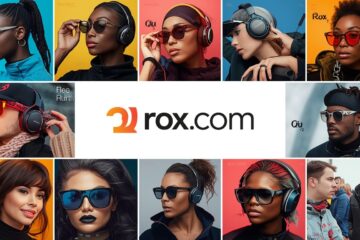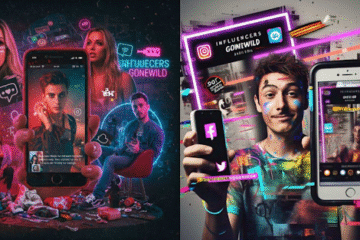In today’s hyper-connected world, brands often rely on influencers to amplify their message, drive sales, and shape public perception. This strategy has become a cornerstone of modern marketing. But what happens when the same influencers, celebrated for their reach and relatability, go off-script and cause controversy? The fallout can be swift, unforgiving, and deeply damaging—not just for the influencer, but for the brands attached to them.
Enter Influencersgonewild, a digital space known for showcasing viral moments where influencers cross the line. What began as a platform for highlighting shocking or unpredictable content has evolved into a lens through which the public evaluates online behavior, ethical responsibility, and brand association. When content that is offensive, exploitative, or irresponsible goes viral, the impact reverberates beyond personal reputations—it threatens brand credibility and customer loyalty.
This article unpacks the growing pattern of brand-influencer backlash, examining real examples, public reactions, and the lessons modern marketers must learn from the wild side of influencer culture.
The Rise of Risky Partnerships
Influencer marketing works because it feels authentic. Instead of slick commercials, brands tap into personalities who appear genuine, relatable, and embedded in everyday life. But as the stakes have grown, so has the pressure on influencers to maintain visibility, relevance, and engagement—sometimes at any cost.
When influencers cross boundaries, whether through insensitive remarks, irresponsible stunts, or cultural missteps, the brands they represent are often caught in the crossfire. These incidents expose a lack of vetting, poor risk assessment, and at times, a disconnection between corporate values and influencer behavior.
Case Study 1: The Wellness Brand That Regretted Fast Influence
A popular wellness brand partnered with a fitness influencer known for motivational content. Initially, the collaboration drove massive engagement, with sales surging in the early weeks. But when the influencer posted a video promoting unverified health remedies and mocked scientific experts, the backlash was immediate.
Critics flooded the brand’s social media pages, questioning its judgment and ethics. Health professionals condemned the misinformation, and customers began boycotting the brand.
The company issued a public apology, severed ties with the influencer, and committed to working with medically certified professionals moving forward. But the damage to its reputation lingered, especially among more health-conscious consumers.
Case Study 2: Fashion Brand Entangled in Cultural Controversy
A fashion label collaborated with a travel influencer known for colorful, edgy content. The influencer posted a photo shoot wearing sacred cultural attire in a disrespectful context, sparking outrage from the community the attire represented.
The image, flagged on Influencersgonewild, went viral. The brand’s comments section filled with demands for accountability and boycotts. Though the influencer apologized, the brand was criticized for not doing enough to understand the cultural context before launching the campaign.
This incident highlighted the need for brands to conduct cultural due diligence and prioritize education over virality.
Case Study 3: Beauty Brand Caught in a Digital Firestorm
A makeup brand signed a top-tier influencer to launch a new product line. Weeks before the campaign, an old video resurfaced showing the influencer using racial slurs during a live stream.
As the video made rounds on platforms like Influencersgonewild, public trust began to erode. Consumers felt betrayed. The brand tried to distance itself quickly, but critics argued the partnership should never have existed in the first place.
In response, the brand established a new internal review board and committed to diversity and inclusion training for its marketing team. But for many customers, the move felt reactive rather than proactive.
The Impact on Brand Trust
When influencers behave badly, the public often holds brands equally accountable. Consumers expect companies to align with certain values—fairness, respect, empathy, and social responsibility. When a brand appears to ignore these principles by associating with problematic influencers, the fallout can be swift and costly.
The effects include:
- Loss of consumer trust
- Decline in brand loyalty
- Negative media attention
- Drop in sales or stock value
- Damage to long-term brand reputation
In the age of conscious consumerism, people are not just buying products—they are buying into narratives. A single misstep, amplified through platforms like Influencersgonewild, can undo years of brand-building.
Why Brands Often Miss the Red Flags
Many companies fall into the trap of choosing influencers based solely on follower count and engagement metrics. While reach is important, it should never outweigh integrity and alignment with brand values.
Some of the most common mistakes include:
- Lack of background checks: Not reviewing an influencer’s past content, affiliations, or public behavior.
- No moral clauses in contracts: Failing to include terms that allow the brand to exit partnerships if an influencer violates certain ethical standards.
- Ignoring warning signs: Overlooking problematic behavior because the influencer is trending or profitable.
- One-size-fits-all campaigns: Assuming an influencer can represent a brand across all audiences, regardless of cultural or regional nuances.
The Role of Influencersgonewild in Amplifying Public Response
Influencersgonewild does not create controversy—it documents it. But in doing so, it provides a centralized space where audiences witness and critique influencer behavior. It acts as a public feedback loop, amplifying reactions and holding digital personalities accountable.
While some see the platform as controversial, its growing relevance speaks to a larger cultural trend: audiences want transparency. They are no longer passive consumers; they actively investigate, react, and mobilize against actions that appear dishonest or harmful.
Brands must realize that in this digital landscape, accountability is not optional. It is expected.
How Brands Can Protect Themselves
In a world where online missteps can go viral in minutes, proactive reputation management is essential. Here are several strategies brands can implement:
1. Thorough Vetting Process
Conduct deep background checks on every potential influencer partner. This includes reviewing past posts, collaborations, and any public controversies.
2. Value-Based Matching
Only work with influencers who genuinely align with the brand’s mission, values, and long-term vision.
3. Strong Legal Contracts
Include clauses that allow termination of the partnership in case of reputational damage, public controversy, or ethical violations.
4. Real-Time Monitoring
Use tools to track influencer content and public sentiment throughout the campaign. Be prepared to respond quickly to emerging issues.
5. Transparent Communication
If a problem arises, acknowledge it directly and honestly. Silence or vague statements often escalate the backlash.
Conclusion
The influencer economy is thriving, but it comes with growing pains. While platforms like Influencersgonewild often expose the darker side of digital fame, they also provide valuable lessons for brands. When a partnership goes wrong, the consequences can be public, painful, and permanent.
But brands that prioritize ethics, alignment, and accountability can navigate this space successfully. Influencers are powerful, but with great influence comes great responsibility—both for them and the companies that endorse them.
In a world where every action is captured, shared, and scrutinized, smart brands must go beyond counting followers. They must follow values, vet content, and stay grounded in the reality that public trust, once lost, is hard to earn back.



